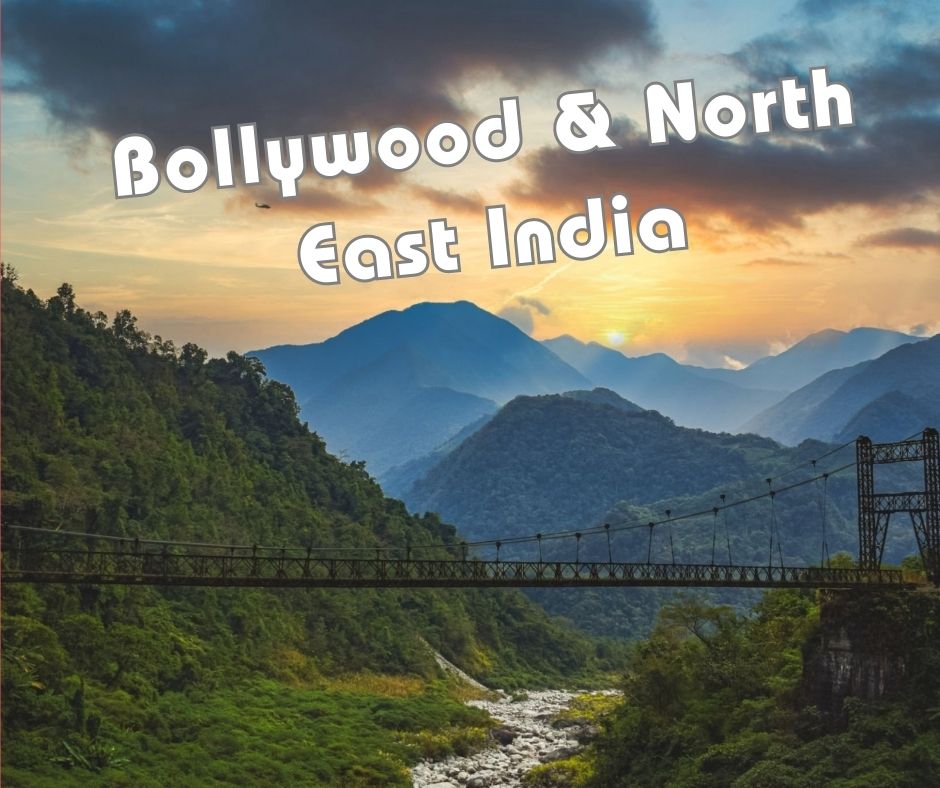Bollywood cinema, often dubbed as the heart of Indian entertainment, has an undeniable influence on shaping popular perceptions of the country’s landscapes and cultures. One such area that has consistently caught the eye of filmmakers is the mesmerizing North East India. With its untouched beauty, diverse cultures, and rich heritage, the North East has served as a captivating backdrop for numerous Bollywood films, offering audiences a glimpse into the region’s natural allure and cultural vibrancy.
Majestic Meghalaya:
Nestled in the eastern sub-Himalayan region, Meghalaya, with its rolling hills, lush landscapes, and cascading waterfalls, has provided a scenic canvas for Bollywood directors to craft their narratives. The charming capital, Shillong, known as the “Scotland of the East,” has played host to several films, including “Rock On 2,” which beautifully captured the city’s thriving music scene amidst its picturesque surroundings. The movie effectively showcased the youthful exuberance of Shillong, presenting its vibrant cultural scene against the backdrop of its serene beauty. Moreover, “Mary Kom,” the biographical film based on the life of the acclaimed boxer, allowed viewers to journey through her struggles and successes while also showcasing the serene landscapes of Meghalaya.
The portrayal of Meghalaya’s pristine landscapes on the silver screen has not only attracted tourists but also shed light on the state’s unique blend of traditional and modern influences. Its vibrant festivals, such as Wangala and Nongkrem, have also found their way into Bollywood narratives, showcasing the state’s cultural richness alongside its natural beauty.
Enigmatic Arunachal Pradesh:
Arunachal Pradesh, often referred to as the “Land of the Dawn-Lit Mountains,” boasts not only breathtaking natural beauty but also a rich tapestry of diverse tribal cultures. This enchanting state has found its way onto the silver screen through films like “Rangoon,” which utilized its untouched landscapes to create an authentic backdrop for its narrative. The film’s lush forests, towering peaks, and winding rivers lent an air of mystery and adventure to the story, capturing the essence of Arunachal Pradesh’s enigmatic charm. Another notable film, “Koyla,” featured the awe-inspiring landscapes of Ziro Valley, emphasizing the region’s unique and captivating characteristics.
Arunachal Pradesh’s portrayal in Bollywood films has helped bring attention to its cultural diversity, with glimpses of traditional dance forms, rituals, and festivals like Losar and Mopin making their way into narratives. The state’s vibrant tribal heritage and breathtaking vistas have sparked curiosity and interest among viewers, prompting them to explore this lesser-known gem.
Tranquil Tripura:
The serenity of Tripura, characterized by tranquil lakes, ancient temples, and vibrant cultural festivals, has also captivated Bollywood filmmakers. “Mukti Bhawan,” a film that explored the complexities of life and death, showcased Agartala’s quaint charm and its surroundings. The film provided a unique opportunity for viewers to witness the tranquil beauty of Tripura and its cultural heritage. The portrayal of the state’s ancient temples, such as the Tripura Sundari Temple, and its serene lakes like Neermahal, have not only added visual appeal to films but have also introduced audiences to Tripura’s historical significance and spiritual essence.
Tripura’s depiction in Bollywood has ignited interest in the state’s cultural festivals like Kharchi Puja and Garia Puja, shedding light on its distinct traditions. This cinematic spotlight has offered viewers a glimpse into the state’s cultural fabric, fostering a sense of connection and understanding.
Captivating Manipur:
Manipur, often referred to as the “Jewel of India,” offers a captivating blend of natural beauty and cultural richness. The state’s serene lakes, unique dance forms, and vibrant traditions have been skillfully portrayed in Bollywood films. “Mary Kom,” for instance, portrayed the boxer’s hometown, Manipur, showcasing not only the backdrop of her inspiring journey but also the region’s mesmerizing landscapes. The film effectively highlighted Manipur’s cultural significance, shedding light on its indigenous art forms, such as the intricate Thang-Ta martial arts and the soul-stirring Ras Lila dance.
The portrayal of Manipur’s cultural identity and landscapes in Bollywood has presented a balanced perspective, showcasing both its challenges and triumphs. As audiences are exposed to Manipur’s struggles and resilience, a deeper appreciation for the state’s rich heritage is cultivated.
Picturesque Nagaland:
Nagaland’s picturesque landscapes, rich tribal heritage, and vibrant festivals have made it a sought-after destination for filmmakers. In the film “Yeh Fitoor Mera,” audiences were treated to the rustic charm and colorful culture of Nagaland. The movie brought to life the region’s unique traditions, allowing viewers to immerse themselves in its distinct identity. The portrayal of Nagaland’s festivals, such as the Hornbill Festival, has offered a visual spectacle of the state’s cultural diversity and artistic expressions.
Bollywood’s lens has captured the spirit of Nagaland, highlighting the significance of its indigenous customs and traditional attires. By showcasing these elements, the film industry has contributed to preserving Nagaland’s cultural heritage while inviting audiences to explore its awe-inspiring landscapes.
Breathtaking Sikkim:
Sikkim, nestled in the lap of the Himalayas, boasts snow-capped mountains, pristine lakes, and monasteries that exude a sense of tranquility. Bollywood filmmakers have been drawn to Sikkim’s scenic beauty, as seen in movies like “Gangtok,” which captured the essence of the state’s capital city. The film’s visuals effectively conveyed the charm of Sikkim’s urban landscapes while also paying homage to its natural splendor. Additionally, “Highway” took audiences on a mesmerizing road journey through Sikkim, showcasing its breathtaking landscapes along the way and giving viewers an intimate experience of the region’s beauty.
Sikkim’s representation in Bollywood has not only provided visual delights but has also deepened the audience’s understanding of the state’s Buddhist culture and traditions. Monasteries like Rumtek and Pemayangtse, which have been featured in films, are not only architectural marvels but also centers of spirituality that reflect Sikkim’s ethos.
Cultural Assam:
The vast tea gardens of Assam, the meandering Brahmaputra River, and the state’s vibrant traditions have all found their way onto the silver screen. “Krrish 3,” a Bollywood blockbuster, featured Assam’s Tea Estates and lush greenery, adding a unique dimension to the film’s visual appeal. Assam’s cultural vibrancy and natural splendor have undeniably left an indelible mark on the world of Bollywood. The state’s portrayal in films serves as a reminder of its integral role in North East India’s cultural mosaic.
The depiction of Assam’s Bihu festival, with its energetic Bihu dance and folk songs, has infused Bollywood narratives with a lively and authentic cultural element. The state’s diverse landscape, which ranges from the lush tea gardens of Jorhat to the wilderness of Kaziranga National Park, has offered a dynamic backdrop for various stories.
Endearing Mizoram:
Mizoram, with its rolling hills, colorful festivals, and warm hospitality, offers a unique blend of natural beauty and cultural heritage. The film “Chameli” utilized Mizoram’s picturesque landscapes to create
a visually stunning backdrop for its narrative. Through this film, audiences were introduced to the endearing charm of Mizoram and its captivating landscapes. The depiction of Mizoram’s culture and landscapes in Bollywood underscores the state’s contribution to the North East’s diverse tapestry.
Mizoram’s portrayal in Bollywood serves as a testament to its indigenous traditions, including the Pukhtaw, a traditional bamboo dance, and the Chapchar Kut festival. The state’s striking landscapes, including the stunning Blue Mountain, have been captured on film, immortalizing their beauty and inviting viewers to delve into Mizoram’s allure.
Cultural Diversity of North East India:
Beyond its breathtaking landscapes, the North East is renowned for its rich tapestry of cultures and ethnicities. Each state within the region boasts a unique heritage, and Bollywood has played a significant role in bringing these diverse cultures to the forefront. The portrayal of Manipur’s traditional dance forms, Assam’s Bihu festival, and Nagaland’s indigenous customs in various films has helped bridge the gap between different communities and regions of India. By showcasing the cultural nuances and identities of North East India, Bollywood has contributed to a greater understanding and appreciation of this vibrant part of the country.
Challenges and Opportunities:
While Bollywood’s portrayal of North East India has undoubtedly brought attention to its beauty and culture, it is essential to recognize the challenges that come with it. The region has often been stereotyped or misrepresented in mainstream media, perpetuating certain biases and misconceptions. However, the growing interest of filmmakers in exploring the authenticity of North East India’s locales and stories is a positive sign of change. As filmmakers increasingly collaborate with local artists and experts, the representation of the region becomes more accurate and respectful.
Encouraging Tourism:
Bollywood’s cinematic magic has the power to transcend screens and influence real-world actions. The portrayal of tourist spots in films has contributed to a surge in travel enthusiasts eager to explore North East India’s locations firsthand. Shillong, Gangtok, and Ziro Valley have seen a rise in tourism, with visitors seeking to capture the same enchanting landscapes they witnessed in films. This influx of visitors not only boosts local economies but also fosters cultural exchange and understanding between residents and tourists.
Preservation of Natural Beauty:
While the spotlight of Bollywood can contribute positively to tourism, it also brings forth the responsibility of preserving the natural beauty and cultural heritage of these destinations. Sustainable tourism practices and responsible filmmaking can ensure that these picturesque spots remain untouched for future generations to enjoy. Collaborations between filmmakers, local communities, and conservation organizations can lead to a harmonious balance between on-screen portrayals and the preservation of these delicate ecosystems.
Bollywood’s journey through the enchanting tourist spots of North East India has been a mesmerizing exploration of both cinematic and real-world beauty. The region’s diverse landscapes, cultures, and traditions have not only provided visually stunning backdrops for films but have also played an integral role in shaping narratives and enriching stories. From the captivating hills of Meghalaya to the serene lakes of Manipur, each state’s unique essence has been immortalized on screen.
As filmmakers continue to weave tales within these spectacular settings, it is crucial to maintain a delicate balance between artistic expression and responsible representation. By collaborating with local communities and understanding the intricate nuances of North East India, Bollywood can continue to contribute positively to the region’s cultural promotion and economic growth.
The enchanting tourist spots of North East India will forever remain etched in cinematic history, inviting audiences to embark on journeys of discovery and exploration. Through Bollywood’s lens, these destinations have transitioned from mere spots on a map to living, breathing characters that leave an indelible mark on the hearts and minds of viewers. As the world looks forward to more cinematic adventures, North East India’s allure will undoubtedly continue to be a beacon of inspiration for filmmakers and travelers alike. With each frame, these films pay homage to the breathtaking beauty and vibrant culture that define the North East.

